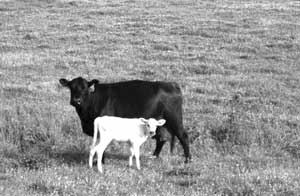|
Might Be A Good Year To Creep Feed Calves
LEXINGTON, KY.
With record-high cattle prices, many Kentucky beef producers might look to creep feeding to put additional weight on calves before weaning. University of Kentucky College of Agriculture, Food and Environment beef specialist Jeff Lehmkuhler isn’t usually a fan of the feeding method, however, he believes it may provide an opportunity this year. If producers are careful, they could cash in.
Creep feeding is when producers provide supplemental feed to animals that are still nursing as a way to efficiently help them grow and attain a higher weaning weight.
Lehmkuhler was quick to point out a few issues of concern about creep feeding including excessively conditioning replacement heifers, inducing acidosis and getting feeders too fleshy. However, with proper management, creep feeding can be an efficient way of putting on pounds pre-weaning.
“As we think about creep feeding, increased pounds at weaning do not necessarily result in a direct increase in profitability,” he said. “We need to more accurately account for feed costs, price slide, equipment investment and labor inputs to look at the potential increase in profit.”
Generally, creep feeding is profitable when feeder cattle prices are high and feed costs are low. To take advantage of that, producers need to creep feed beginning the 60 days prior to weaning. Producers who plan to wean calves in November should start now.
“Creep feeds are generally higher in crude protein to overcome any protein limitations in the forage being offered,” Lehmkuhler said. “Young calves are in a lean phase of growth and supplementing marginal forage can improve calf performance. With ample forage regrowth this fall in the upper Southeast, energy supplementation is needed more than protein for many operations. Therefore, a 14 to 18 percent crude protein range would be acceptable in creep feeds to complement available pasture forages.” With the availability of low-starch coproduct feeds, such as soybean hulls, corn gluten feed and distillers grains, the risk of acidosis is much less when feeding these coproducts compared to grain-based, high-starch creep supplements. However, producers can use a mixture of grains and coproducts.

PHOTO: Matt Barton, UK Agricultural Communications
“Frankly, there is not a single creep feed mixture that is the best for every situation,” Lehmkuhler said. “You need to factor in the composition of the forage, predicted or desired creep supplement intake, and the calves’ nutritional needs when designing a creep supplement. Also, don’t overlook the possibility of creep grazing, as it can be a cost effective strategy to add some inexpensive gains.”
Creep grazing is when producers allow calves to graze specific, high-quality forage areas, separately from the cows.
Lehmkuhler offered a few tips to help put together a creep supplement and to manage the feeder.
• Keep the fines and dust to a minimum.
• Consider if feedstuffs will have sorting/settling issues that may lead to inconsistent intakes and nutrient balance.
• Avoid adding excessive moisture (i.e. liquid molasses or ear corn that is not dry) as it can lead to caking in feeders.
• Avoid non-protein nitrogen sources.
• Avoid excessive roughage products such as cottonseed hulls that could cause bridging and separation.
• When starting to creep, limit the amount placed in feeder and frequently monitor it.
• During humid weather, consider more frequent filling to avoid caking.
• Keep feeders on a high-traffic use pad or concrete to avoid muddy conditions around feeder.
Producers who need more information about creep feeding, or other livestock feeding concerns, should contact their local county extension office. ∆
|
|